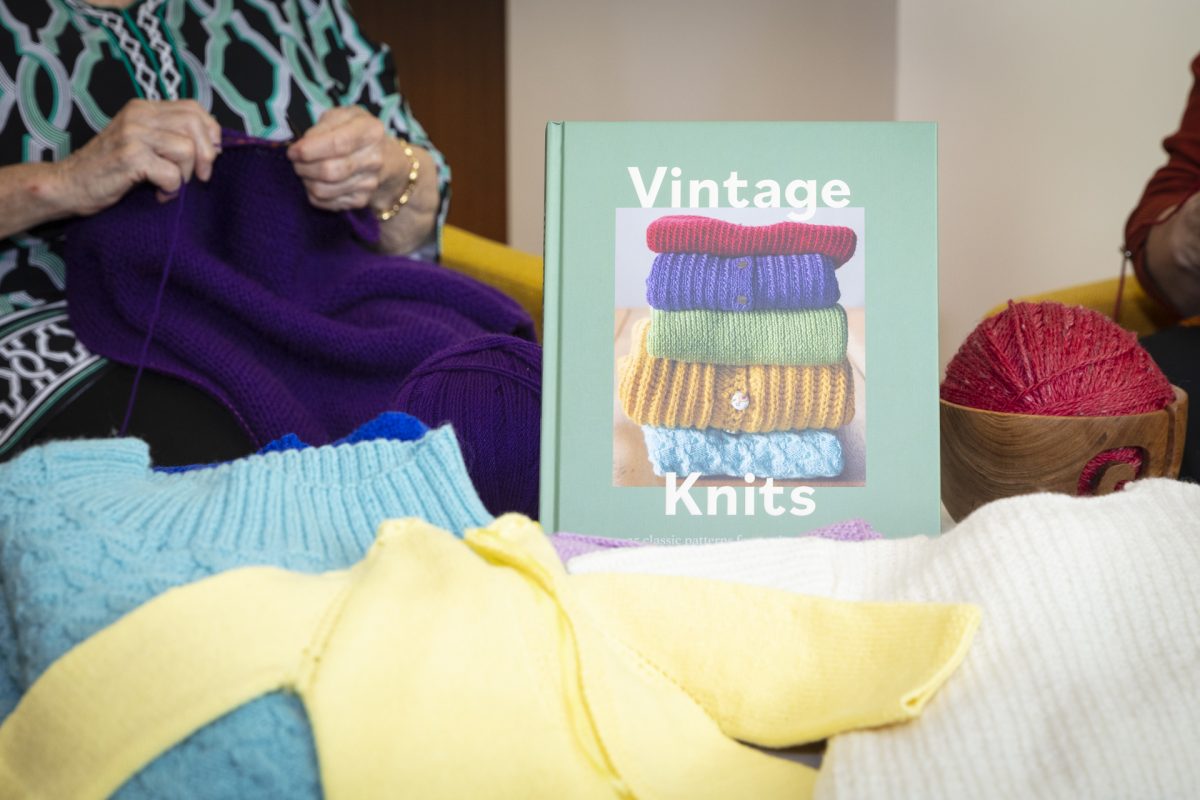
Judith Robertson and Kate Boesen volunteered to bring old knitting patterns to life for the NLA’s new book, Vintage Knits. Photo: Thomas Lucraft.
Kate Boesen had been working at the National Library of Australia for almost 20 years when the call came for skilled knitters to participate in a new project.
The Library trove contained stacks of vintage magazines from the early 20th century – back when knitters had their pick of patterns published regularly in magazines and newspapers. The publication team had decided to collate a curated selection of them for a book and needed volunteers to recreate the patterns.
Kate knew she was one of them.
“I have been knitting since I was a girl,” she said. “My grandmothers both introduced me to knitting and my mother and mother-in-law both taught me, so my skills are the result of generations worth of help.”
In bookstores now, Vintage Knits will present 25 women’s, men’s and children’s vintage knitting patterns from Australian publications of the 30s, 40s and 50s, tested and updated to make them practical for today’s knitter.
The book places content from the original publications alongside contemporary full-colour photographs of the garments as recreated today, with reflections on the social and cultural history of knitting in Australia woven throughout. It taps into current vintage and handmade trends and the resurgence of knitting.
In an age of online shopping, mass production and fast fashion, Kate has a few ideas to explain the artform’s revival, which seems to belie the modern obsession with instant gratification.
“I think there are a few strands – so to speak – that explain why knitting is popular again,” she said.

“Just the prettiest thing for afternoon wear” – the ‘Lorraine’ was recreated for Vintage Knits. Photo: Thomas Lucraft.
“The first is how well connected we are. It’s easy now to learn a new skill on YouTube or ask an online community. If I don’t know how to do a particular stitch, I can look up a video in minutes.
“Secondly, we’re so stressed and preoccupied in our everyday lives with big issues – floods, fires, pandemics and wars. We’re looking for things to take our minds off the monumental. Knitting is so meditative; it’s using your hands to keep your mind off anything else.
“Lastly, it’s fashionable again because you can create whatever you can imagine. That creativity and individuality appeal to a younger audience.”
For Vintage Knits, Kate recreated a pattern published in Women’s Weekly on 25 March 1939, just before the outbreak of WW2.
“It was this cute little thing called the Florence and it was described as ‘a fascinating little jumper in which to go skittering hither and yon – at a moment’s notice, perhaps’,” she chuckled.

Classic patterns are remade for modern times in Vintage Knits. Photo: Thomas Lucraft.
Throughout the process, the volunteers had to nut out the challenges of knitting a vintage pattern within today’s parameters, so the book could present readers with a seamless process.
“The Florence pattern is only for one size, for starters. It’s very fitted and you basically need a 36-inch bust to wear it,” she explained.
“There was a fair bit of assumed knowledge – they didn’t provide detailed instructions on how to put the thing together. I had to look up a few things.
“Four-ply wool makes it very light. It’s called ‘fingering weight’ and it’s for very delicate things. I had mostly knitted eight-ply or 10-ply; this was the lightest garment I’ve ever knitted.”
Despite the challenges, Kate said the Florence was the “the best thing” she has ever knitted and she couldn’t wait for people to see it modelled in Vintage Knits.
Fellow volunteer Judith Robertson similarly had to work around a couple of challenges when recreating the ‘Pamela’ – an angora pullover intended for a seven-year-old.
“I think most if not all of us found the patterns came out smaller than expected,” she said. “I reckon my pullover for a seven-year-old could have fit a four-year-old.
“The first test run came out much too small, so we agreed I’d go up one needle size.”
But pivoting on the original pattern is a delicate balance, Judith explained. Going up a needle size creates a looser weave and makes the garment bigger but too much and you can compromise the garment’s structural integrity.

The modern recreations were modelled for large photos in Vintage Knits. Photo: Thomas Lucraft.
Judith also transcribed the selected patterns from Trove’s electronically-captured records of the old publications, painstakingly typing them up for the book.
“Some of the people as they were knitting found there were mistakes – not just in my typing but in the magazines,” she said.
Volunteers have tinkered, tested and retested so readers don’t have to. The result is a visually-charming sample of the Library’s records exploring an art form that is thriving today as part of the ‘handmade revolution’ and our collective fascination with all things vintage.
Vintage Knits is out now and available at the National Library of Australia bookshop.
Original Article published by Dione David on Riotact.







